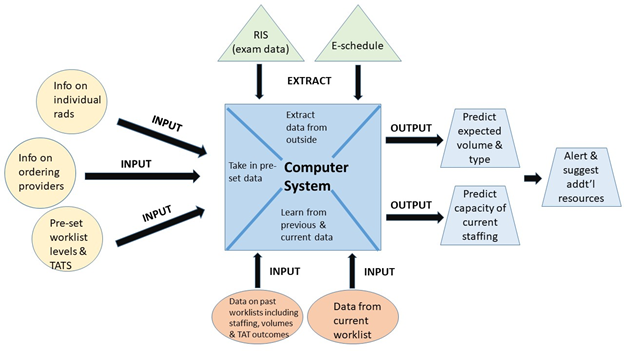|
Purpose |
By predicting the number and types of exams that are likely to be encountered in a given time period, the system allows for appropriate staffing in terms of number and types of radiologists. This should reduce turnaround time and improve work balance of radiologists. Algorithm may also suggest when to request back-up assistance based on predicted workload and staffing. |
|
Tag(s) |
#WorklistManagement |
|
Panel |
Non-Interpretative, Business-Facing |
|
Define-AI ID |
19100001 |
|
Originators |
Rich Heller, Woojin Kim, Worth Saunders |
|
Panel Chair |
Rich Heller |
| Non-Interpretive Panel Chairs | Alexander J. Towbin, Adam Prater |
|
Panel Reviewers |
Business Facing Subpanel, Non-Interpretive Panel |
|
License |
|
|
Status |
Clinical Implementation
Value Proposition
Accurately predicting the interpretive worklist volume and case mix is challenging. This often causes problems for those charged with setting radiologist work schedules for a practice. The goal of this use case is to apply machine learning algorithms to historical and ongoing data from a facility to predict interpretive worklist volume and type and thus predict staffing demands. Such an algorithm could distinguish preferences and expertise (both explicitly or implicitly) of radiologists on staff, as well as use historical data on their individual and collective productivity. The machine learning tool could learn from past staffing and scheduling assignments with both positive and negative outcomes as inputs. As a result, the tool could help insure better and more appropriate staffing, thus limiting delays in turn-around. It could also predict when additional staff are likely to be needed, and suggest sub-specialties or even specific radiologists that would be most useful.
Narrative(s)
A 17 radiologist practice provides around-the-clock services to a large community hospital and its off-campus outpatient imaging center. They have struggled to provide optimal service due to variations in volume and case mix. They would like a system that can help them create a smart schedule based on expected volumes, types of exams and radiologist capacities and sub-specialty preference. Ideally, it would also alert them when they should request additional assistance to manage the worklist.
Workflow Description
User prompts the algorithm to predict incoming exam volume and type over a select time window. This prediction can be used to create a schedule of radiologists or be compared to staff on the current schedule. The algorithm will also learn each radiologist’s rate of dictation per unit time for each exam type. Accounting for their productivity, expertise, case mix and volume, the algorithm evaluates if the staffing is appropriate. If not, the user is notified of recommended changes to more accurately meet predicted demand. As studies come in, the algorithm evaluates specific features about the exams and assesses the appropriateness of the staffing.
Technical Specifications
Inputs
Exam Characteristics
|
Definition |
From the Radiology Information System (RIS): Features of an exam such as modality, location of exam, body part, wRVU, patient demographics, referring provider, and indication, as well as related exams obtained at the same time. |
|
Potential Feature(s) |
Modality, body part, patient demographic (age & sex), indication, referring provider, similar exams ordered at the same time, location of exam (point of service and location in hospital) |
Schedule Data
|
Definition |
From the electronic schedule |
|
Potential Feature(s) |
The names of radiologists on schedule at certain days & times |
Individual Radiologist Information
|
Definition |
Information on each radiologist in the practice based on the selection criteria of the facility. This may include radiologist’s preference, the rate of dictation, and subspecialty expertise |
|
Potential Feature(s) |
Radiologist Preference (For example, neuro radiologist may prefer to read spine. May be applicable at large academic institutions) , Radiologist Expertise |
Radiologist Turnaround Times and worklist levels
|
Definition |
Delivery of timely information to the healthcare team as needed; can be defined as the time from report available on the worklist for interpretation to the final report signed. May also define goals for worklist levels at certain times. |
|
Potential Feature(s) |
Turnaround time |
Ordering Provider Characteristics
|
Definition |
Information about the ordering provider and their attributes that might affect study delivery |
|
Potential Feature(s) |
Ordering Provider name , speciality of ordering provider, specified preference from ordering providers on a speciality or subspeciality to read the study, Specified preferences from ordering providers on who to read the study (if applicable), Other specified preferences for how to read the study (protocol on read, if applicable) |
Historical Staffing and Worklist data
|
Definition |
Historical data on how the facility was staffed, with types of radiologists, names of specific radiologists and outcomes data (turn-around times) |
|
Potential Feature(s) |
Ongoing schedule |
Current Worklist data
|
Definition |
Up-to-date data on exam volumes and types |
|
Potential Feature(s) |
From the worklist |
Primary Outputs
Volume Prediction For a Given Time
|
Definition |
Predicted number of total studies and the types of exams the facility will receive in a time window |
Radiologist Capacity
|
Definition |
Volume and type of workload that the current staffing could handle in a time frame |
Secondary Outputs
Staffing Suggestions
|
Definition |
Suggest changes to staff for a specified time window based on the predicted workload and available staff |
Figures
